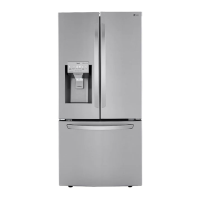32 OPERATION
Before Using the In-Door Icemaker
• Ice is made in the automatic in-door icemaker
and sent to the dispenser. The icemaker
produces 70 - 182 cubes in a 24-hour period,
depending on freezer compartment
temperature, room temperature, number of
door openings and other operating conditions.
• It takes about 12 to 24 hours for a newly
installed refrigerator to begin making ice.
• Ice-making stops when the in-door ice bin is full.
When full, the in-door ice bin holds
approximately 6 to 8 (12-16 oz.) glasses of ice.
• Foreign substances or frost on the ice-detecting
sensor can interrupt ice production. Make sure
the sensor area is clean at all times for proper
operation.
• To increase ice production, use the Ice Plus
function. The function increases both ice making
and freezing capabilities.
In-Door Icemaker
a Power Switch
b Auto Shutoff (feeler arm)
Before Using the Freezer Icemaker
This feature is only available on some models.
The feature may vary depending on model
purchased.
• Throw away the first bin full of ice after
installation. This is also necessary if the
refrigerator has not been used for a long time.
• The icemaker begins producing ice
approximately 48 hours after the appliance is
initially installed.
• The sound of ice dropping into the ice bin is
normal.
• If the ice bin is completely filled with ice, ice
production will stop.
• The amount and shape of ice may vary according
to the environment (ambient temperature
around the appliance, frequency of the door
being opened, amount of food stored in the
appliance, water pressure, etc.).
• In the event of a power outage, throw away the
ice stored in the ice bin.
Freezer Icemaker (Craft Ice
TM
)
This feature is only available on some models.
a Feeler Arm
b Power Switch
• Do not insert round ice into the in-door ice bin,
as it can damage the ice and water dispenser.
• The icemaker begins producing ice
approximately 48 hours after the appliance is
initially installed. The first batches of ice may not
be round and clear.
• Following installation or water filter
replacement, the first few batches of ice may be
semicircular or contain air bubbles.
• If the water pressure is less than 20 psi (138 kPa)
or a reverse osmosis system is used, the shape
of the ice may vary.
• The ice may look cloudy depending on the water
quality in the installation location and the
operating conditions.
• Throw away any shards of ice you may find in the
ice bin, as they may stick to the ice stored in the
ice bin.
• After a short term power outage, it will take
longer to make the first batch of ice, and the ice
may not be round. If the power will be out for a
longer period, throw away the ice stored in the
ice bin.

